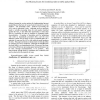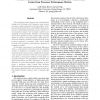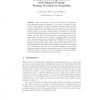201 search results - page 28 / 41 » Reducing the number of clock variables of timed automata |
NIPS
2007
13 years 9 months ago
2007
Point-based algorithms have been surprisingly successful in computing approximately optimal solutions for partially observable Markov decision processes (POMDPs) in high dimension...
AICT
2010
IEEE
12 years 11 months ago
2010
IEEE
Among the various options for implementing Internet packet filters in the form of Access Control Lists (ACLs), is the intuitive – but potentially crude – method of processing t...
EOR
2007
13 years 7 months ago
2007
Motivated by an underground mining operation at Kiruna, Sweden, we formulate a mixed integer program to schedule iron ore production over multiple time periods. Our optimization m...
HPCA
2009
IEEE
14 years 8 months ago
2009
IEEE
The shrinking processor feature size, lower threshold voltage and increasing clock frequency make modern processors highly vulnerable to transient faults. Architectural Vulnerabil...
ECOOP
2004
Springer
14 years 29 days ago
2004
Springer
After two decades of effort, type inference for dynamically typed languages scales to programs of a few tens of thousands of lines of code, but no further. For larger programs, th...



